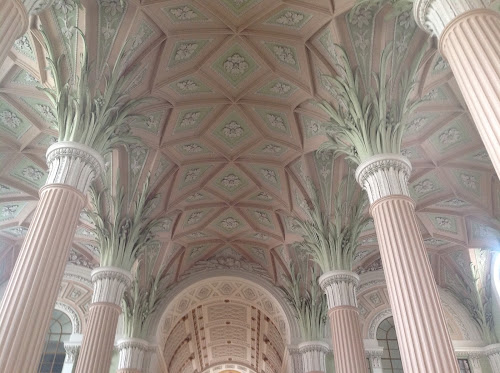I really don't have much to say about Prague; I visited it on February 26th and 27th, right after my parents returned to America. I chose Prague because it wasn't going to be a long train ride from Berlin, and it wasn't much most expensive going there and then back to Frankfurt than riding back direct from Berlin to Frankfurt.
One thing that really helped is that I stayed with an LCMS pastor who's working on international missions in the city, Pastor Tony Booker. Although he graduated shortly before I got to CTS, I had heard about him and knew that he spoke German. As it turns out, he speaks Russian as well and is learning Czech. He's the pastor of St. Michael Lutheran Church, and if you're out that way, I encourage you to meet up with him. He was very gracious to let me sleep on a spare bed/couch that he had.
He also told me a lot about Prague's history, especially about Jan Hus and his efforts at reformation there. I knew that in the Leipzig debate with Eck, Luther was called a Hussite (the term as it turns out had previously been a derogatory name for heretics), and after doing some research, he affirmed the title. He also saw himself as going farther than Hus though, because grabbed at the jugular of the problems- justification by works versus justification by faith. Hus, you see, railed against the abuses of the Roman Catholic Church in Prague, but he did not make it much of a theological problem. He saw the church as very wealthy, having been given land by wealthy land owners upon their death so that they might not go to purgatory. After years of this happening, the Roman Church owned almost all the land in the area surrounding Prague, and would give the administration of this land to various priests! So you can see that if you're renting land from a priest, and he wasn't being fair, how tensions could develop. Compound this with poor clerical morality and greater burdens on the poor, and it was a powder keg waiting to happen. And so, Jan Hus came out of that environment and criticized the practices of the Roman Church; he was later condemned and sentenced to death in 1415 at a council in Constance. This led to religious wars with the new "Hussite" movement, which burned churches and monasteries until a political-religious compromise was reached. In my mind, one can see correlations between this movement and Thomas Müntzer's Peasants' War. But anyway, there's a statue to Jan Hus in the main square of Prague; it's a nationalistic picture of him as a hero for the people rather than a reformer. It looks ugly.
Nonetheless, the history of Prague is fairly interesting. It can boast of the first university in Central Europe, in 1348; the German theologians in fact split from it in the early 15th Century during the Hus controversy to form the Leipzig University (they were at that time in favor of the Pope and wanted to see Hus condemned as a heretic sooner than he was). It used to be the seat of the Holy Roman Emperors Charles IV and Sigismund. Under Charles IV the Prague Castle was built, and depending on how you want to measure it, is the largest castle complex in the world. See this article if you want a comparison.
I got to see the hourly changing of the guard!
The St. Vitus Cathedral was very impressive.
Also on the castle complex was the Old Royal Palace, where the current President resides.
The castle grounds commanded a stunning view of the area!
There are a few other things that Prague is known for. Their astronomical clock is very touristy, so I saw it.
I also saw the Charles Bridge, which is perhaps what Prague is most well known for. It stands where the first bridge over the Vltava River stood, which is the primary reason for the city being where it is. It has been rebuilt throughout the years in response to various floods. It is a stunning combination of a Gothic bridge with Baroque style statues lining its sides. On either end are the Old Town Bridge Tower and the Lesser Town Bridge Tower, which is on the Palace side.
Lesser Town Bridge Tower
Old Town Bridge Tower
Some statues on the bridge
Finally, it's important to realize that Czechoslovakia was controlled by communist rulers after WWII, and that the people today even feel that impact. There's a strong contrast between what were known as the "Happy Bohemians" and the Czechs of today. Shortly after the downfall of the USSR, the Czech Republic and Slovakia separated in what's called the "Velvet Revolution." They are now separate countries, representing separate peoples.
I couldn't help but take this picture of the Prague Underground:
Here is the album for all the photos:
https://www.facebook.com/media/set/?set=a.10151513637768788.1073741832.500163787&type=1&l=11c677b89d



















































